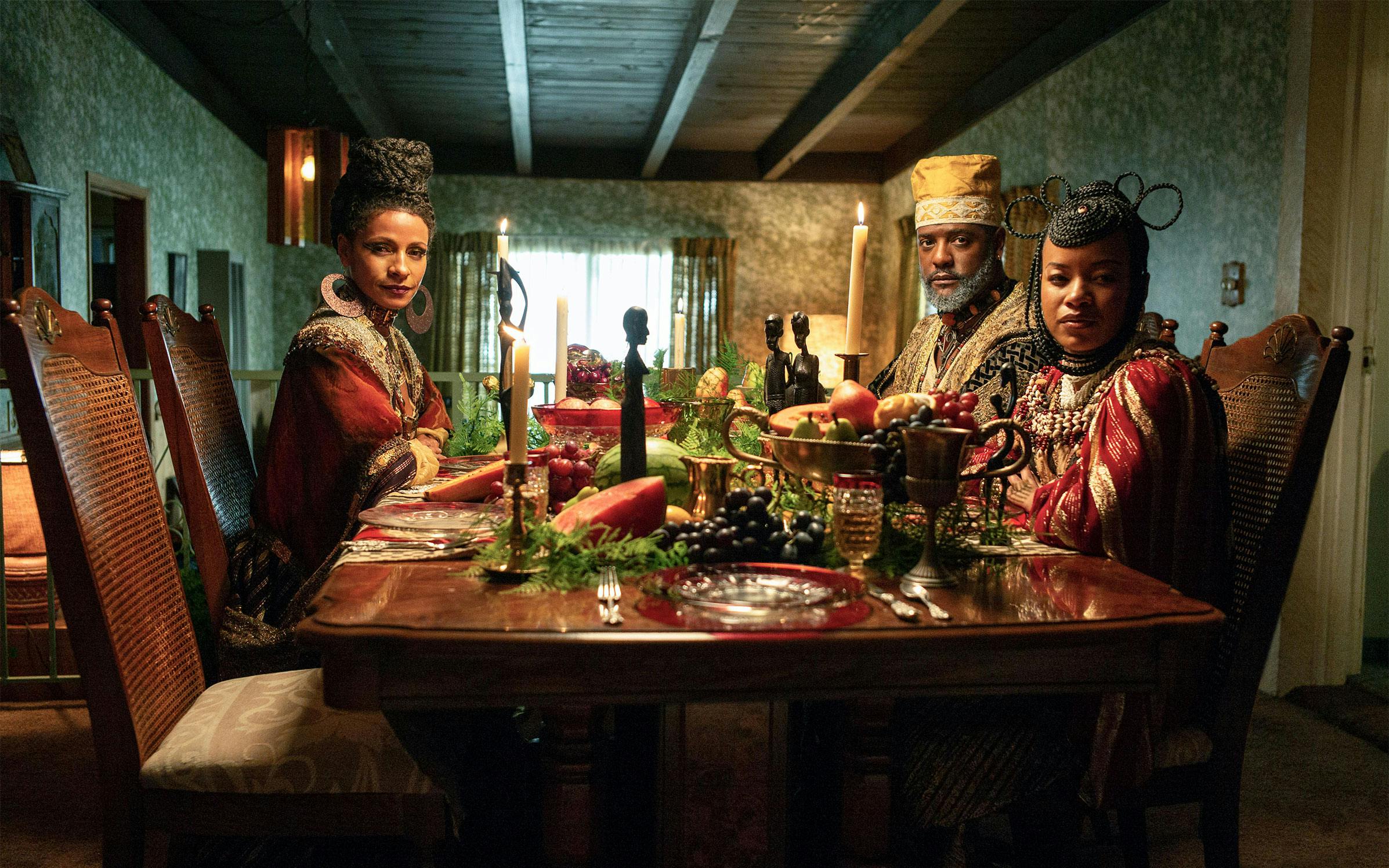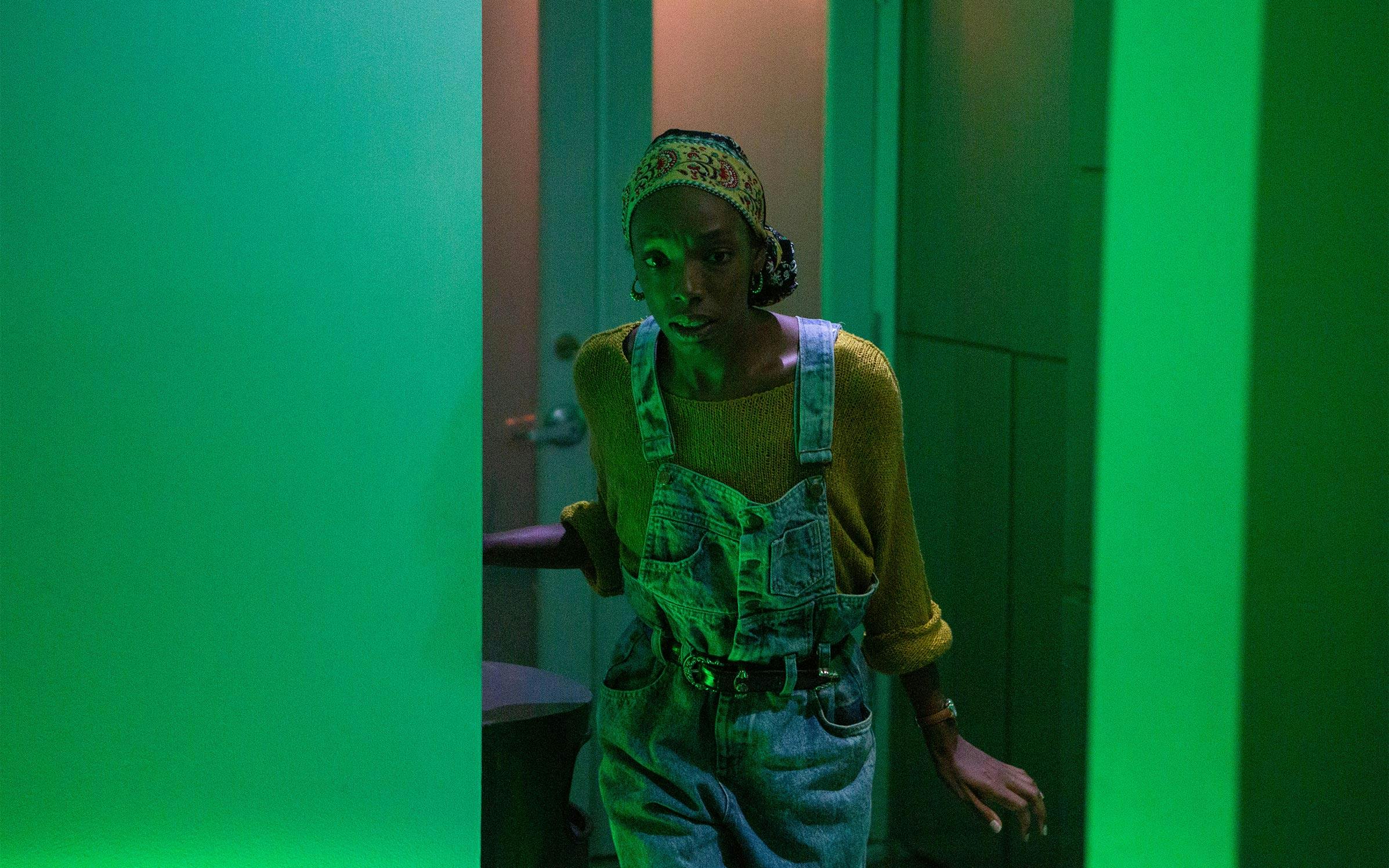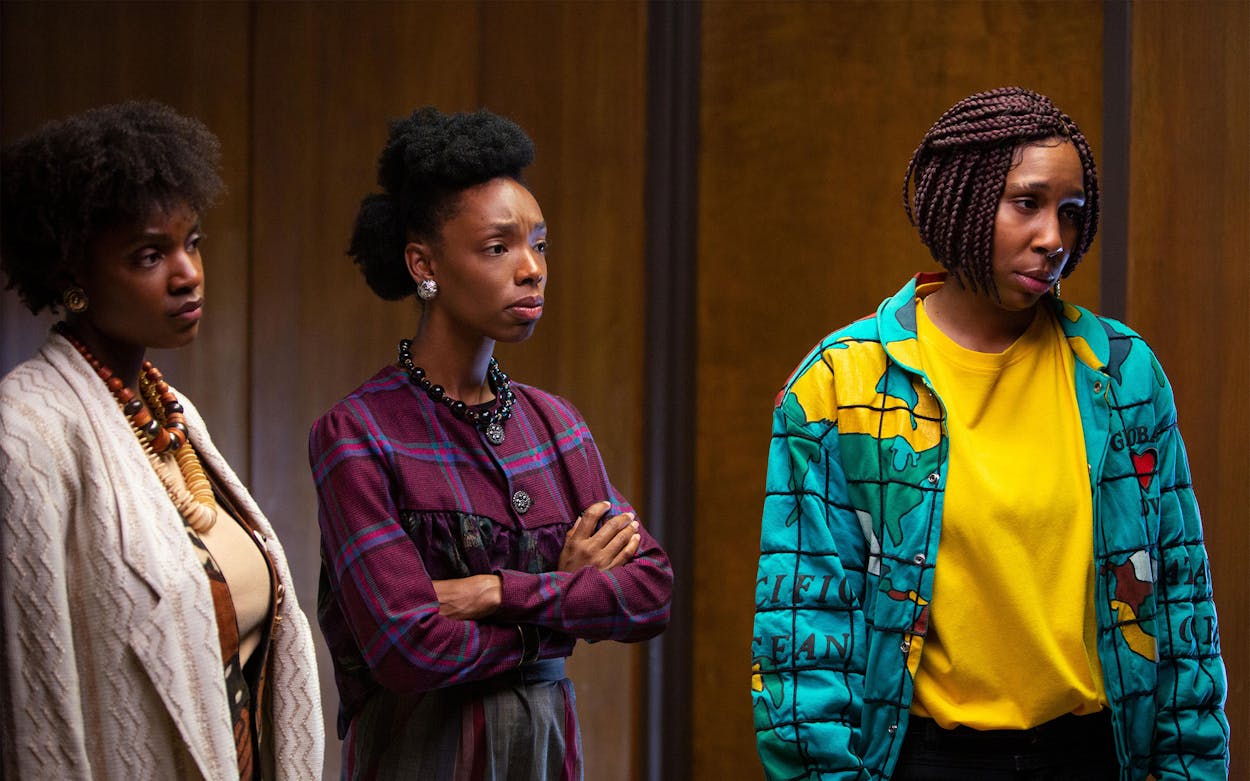Bad Hair, the second feature film directed by Houston native Justin Simien, premiered at Sundance in January. Hulu quickly wrote an $8 million check to snatch up distribution rights for the satirical horror film, outbidding heavyweights like Netflix and Lionsgate. In January, we lived in a completely different world, and Simien was likely going to have a helluva year. The final season of his beloved Netflix series, Dear White People, was slated to air on Netflix (it’s now in production after a long delay) and Bad Hair was supposed to be released in theaters, potentially becoming the fall’s underdog hit. The pandemic scuttled those plans.
This is a shame, because once Bad Hair ramps up and wipes its hands clean of its expository duties, it’s a wild ride—a devilishly fun satire, clearly conceived with the communal movie theater experience in mind. As I watched the film on Hulu from my couch, I yearned for the audience reactions that would’ve happened in the theater: cheers, gasps, outbursts like “Don’t go in there!,” and raucous laughter. At select drive-in theaters across the country (including the Moonstruck and Blue Starlite in Houston and Austin, respectively), movie-goers had the opportunity to park their cars, tune into a radio signal, and experience the film on a giant screen. It’s something, but it just ain’t the same.
Bad Hair stars Elle Lorraine as Anna Bludso, an ambitious twentysomething in Los Angeles in 1989. Anna’s dream is to become a video jockey at the 24-hour music television station where she works as an assistant. When network brass shake up the company and her mentor Edna (Judith Scott) is replaced by a haughty, intimidating supermodel, Zora (Vanessa Williams), Anna worries her dreams may get deferred. This isn’t the case. Despite the fact that Anna’s a fidgety basket of nerves, Zora takes a liking to her because she has great ideas. She offers to promote Anna under the condition that the younger woman replace her natural hairstyle with a straightened one that’s a more “professional” representation of the network’s brand. Anna—tender-headed, wincing, crying, and eventually even passing out from the pain—finds herself in a posh salon called Virgie’s, where she gets a killer weave, or hair extension, sewn into her scalp. The stylist tells her to moisturize her scalp with a fictional version of Luster’s Pink Lotion (a staple in many Black households) and includes a grave warning: “Whatever you do, don’t get your hair wet.”
Anna quickly learns that the weave has a mind of its own. At first, it seems like a protector: When Anna is sexually assaulted by her seedy landlord, the hair sticks its tendrils deep into his skin and extracts his blood, killing him. The film doesn’t want us to feel bad about this—he is the villain in this scene, after all. But it soon becomes clear that the weave is a villain too. There’s no rhyme or reason to who the weave slaughters. It’s just on a hunt for blood.

Folklore is a key theme in Bad Hair. Anna doesn’t believe in superstitions, and she looks down on her family members, most of whom do. Her uncle, Amos (Blair Underwood), isn’t pleased and responds: “You subjugate a people by telling them their science is superstition, their faith is heresy, and their wisdom is make-believe. They called the American Indians savages and they called us … well, what didn’t they call us?” He argues that the superstitions she thinks are beneath her are “rivers and tributaries leading to an ocean of truth” about who she, as a Black person, truly is.
Amos makes a decent point. The Bible is full of supernatural anecdotes—a talking snake and a divine man walking on water is among many. These stories aren’t any less surreal than the spiritual teachings of Native Americans or West Africans; they’re only considered more legitimate and worthy of devotion because they’re part of a dominant culture. To the victor goes the spoils.
Simien invents a piece of folklore for Bad Hair that draws on the trope of Circassian beauties, also called “moss-haired girls.” As early as the Middle Ages, these curly-haired, light-skinned women from the Northern Caucasus region of present-day Russia were depicted in art and literature as exotic beauties. They were considered especially desirable as concubines. In Simien’s twisted take on this history, an enslaved woman dons a wig that kills her master, but when she looks in the mirror, she sees someone else staring back at her. The wig is inhabited by the souls of witches who feast on blood until they grow strong enough to take over the body they sit atop. This is the plan Anna’s weave has, as well as those of Zora and everyone who got their hair done over at Virgie’s. If all of this sounds silly, that’s because it absolutely is.
While Bad Hair is filled to the brim with weighty subject matter, it also pays direct homage to campy B-movie horror of the seventies and eighties. Bad Hair is less like the assortment of prestige horror films getting green-lit by Hollywood today, such as Get Out, Hereditary, or It Follows, and much more like Invasion of the Body Snatchers, Friday the 13th, and Child’s Play. The film is at its best when it leans into over-the-top absurdity, as when forty-foot-long strands of hair chase a screaming character through a hallway. Simien also deploys a deft and affectionate touch in re-creating the style of the eighties and early nineties. Unless you’re a historian of new jack swing, you’ll question whether the songs he wrote for the film’s Janet Jackson–esque pop star, Sandra (played by Houston native Kelly Rowland), are actually from the era. Ceci, the film’s costume designer, gets the vibrant colors, boxy clothing, and geometric designs of 1989 perfect down to every last detail.

As a B-movie send-up, Bad Hair is marvelous. As a social critique, it’s frizzy and has split ends. The idea that Black people, especially women, should embrace their natural kinky, curly hair and eschew Western beauty standards isn’t new, and it’s not clear exactly how the film builds on this well-worn message. Bad Hair leaves some important questions unanswered. What about a Black woman’s agency? Anna never wanted a weave, but what about the many Black women who wear weaves and still cherish their natural hair, who they are, and where they come from? The film doesn’t take into account the pure joy Black women can experience when swapping one style for the next—luscious blond locks one day and a big 4C Afro another. Just as natural hair can be a symbol of Black power, a weave or a wig can be a powerful tool of expression. These ideas can and do coexist, but the film doesn’t explore them.
Horror movies have seen a renaissance in the past decade. They’re being taken more seriously by viewers and critics who don’t traditionally care for the blood-soaked genre. This is in large part because of the aforementioned films It Follows, Hereditary, and Get Out, but also movies like Under the Skin, The Babadook, It Comes at Night, and The First Purge. Their themes, driven by social commentary, have helped the genre earn prestige. But in fact, horror movies have always been socially conscious. George A. Romero’s Night of the Living Dead, which was released six months after Martin Luther King Jr. was assassinated, provides commentary on the nature of war and inadvertently plays as a critique of racism in America. Bill Gunn’s experimental 1973 masterpiece, Ganja & Hess, is a film about religion, Black identity, and the devastating effects of addiction.
The themes in horror movies haven’t changed, though the budgets, acting, and scripts have all improved over the years. The one thing that is drastically different is who has been allowed to tell the world what frightens them. Horror has long been a genre dominated by white men, but more and more fright fests are being written, produced, and directed by women and people of color. Justin Simien uses Bad Hair as a vehicle to give the world a contemporary Black fable on the dangers of assimilation. He also wisely ditches an overly serious tone to create a zany, uniquely amusing farce. Maybe it doesn’t matter all that much that Bad Hair didn’t get a true theatrical release, because it’ll be right at home as a beloved midnight movie.






